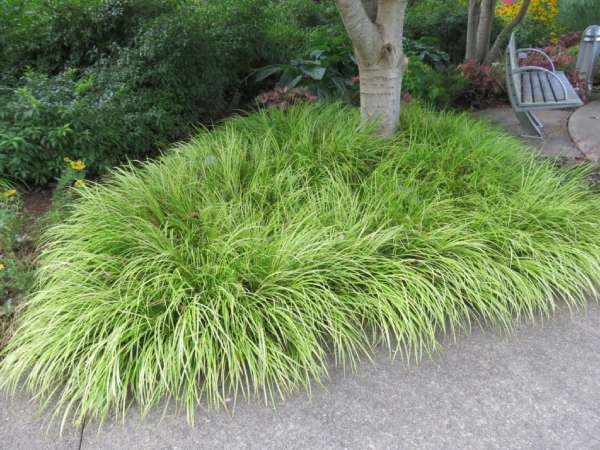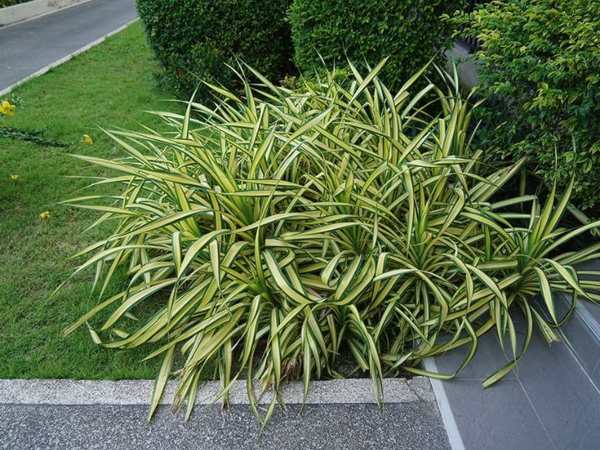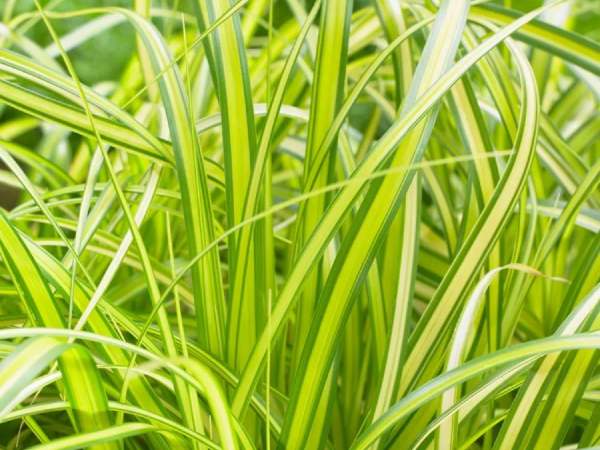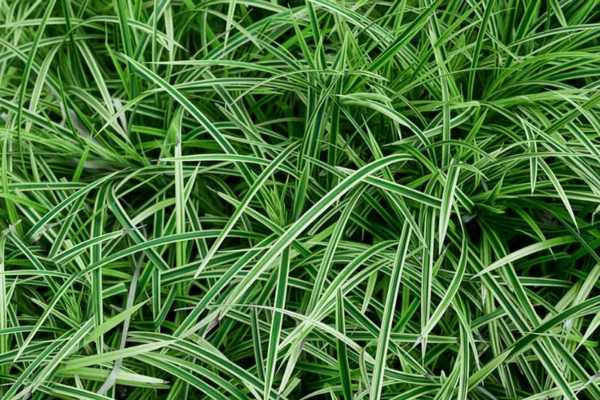Japanese Sedge, also commonly called Morrow’s sedge or ever gold carex is a semi-deciduous rhizomatous evergreen native to Central and Southern Japan. This plant’s main feature is its densely tufted tussock of slim foliage that shimmers when there is a breeze, with flat, dark green leaves that are 12 inches long and 1/4- to 1/2-inch wide.
This plant forms a dense clumping and mounding and it does best when planted in spring. This plant’s growth rate is moderate and reaches its mature height and width in about two years. In mid to late spring, unnoticeable brown flowering spikes grow on the plant.
Plant Attributes
- Common Name: Japanese sedge, evergold carex, Kan suge, Morrow’s sedge
- Botanical Name: Carex morrowii
- Family: Cyperaceae
- Plant Type: Perennial
- Mature Size: 12–18 in. tall, 18–24 in. wide
- Sun Exposure: Partial, Shade
- Soil Type: Moist but well-drained
- Soil pH: Neutral, acidic
- Hardiness Zone: 5–9 (USDA)
- Native Area: Asia
Japanese Sedge Care
Luckily, Japanese Sedge is a versatile plant as it befriends flowering bulbs and perennials easily. Furthermore, it is a nice way to have texture in your landscape. You can use this plant in garden beds or as a border plant and it can also be grown around ponds or water gardens because it loves moist soil. Additionally, it looks good while growing in containers and rock and cottage gardens. It will do extremely well in shadier spots like beneath trees and shrubs.

Planting Japanese sedge in mass will attract a slew of pollinators like bees and pollinators in your yard. This plant is deer-resistant and easy to care for as long as the weather is not cold. Moreover, there are rare cases of pests and other diseases.
Light
These plants thrive in shady areas like in spots shaded by buildings or trees. They can also survive under partial sunlight (no more than four to five hours of partial sunlight a day). Japanese sedge’s foliage will get bleached and fade its color eventually when exposed to too much sun.
Soil
Plant your Japanese Sedge in any soil that is fairly moist, fertile, and well-draining. This low-maintenance plant can adapt to different soil types like chalk, sand, loam, or clay. However, it doesn’t like dry soil.
Water
You must water Japanese sedge consistently, especially while they are established in your landscape. The best way is to drench the plant when you feel the top layer of the soil has dried out and do not leave the ground completely dry too. Once the plant slowly becomes established in your landscape, it will be drought-tolerant. While watering this plant, be careful that you water the base of the plant instead of the dense foliage as this will minimize the risk of fungal diseases.
Temperature and Humidity
These plants love cool weather and grow best when temperatures are below 75 degrees Fahrenheit. Not only that, they also tolerate different temperatures and there are no such humidity requirements. That said, the plant hates very cold winters and to protect them during this time, you can cover it with a thick layer of organic mulch around its root zone.
Fertilizer
Do not worry about fertilizing your Japanese Sedge plants because they are very easy and low-maintenance plants that take care of themselves once established. They will also do just fine without any extra nutrients.
Types of Japanese Sedge
More than 1500 species of Carex grow in moist-to-wet areas globally, making it a challenge to identify individual species. People often confuse a variety of common grass types in the Carex genus with Japanese sedge, like foothill sedge and tussock sedge. That being said, there are a variety of Japanese Sedge many of which have the same care requirements but a slight difference in color and appearance. They are:

- Carex morrowii ‘Variegata‘: This varietal resembles Japanese sedge but has leaves that have a bright white margin on either side.
- Carex oshimensis ‘Evergold‘: This varietal has creamy yellow leaves that consist of bright green margins. Just like Japanese sedge, it grows in a low, grass-like mounded clump.
- Carex morrowii ‘Silk Tassel‘: This one here is the most unique of this lot. This varietal has thin, whispy, and green-silver-colored leaves. The fine texture of the leaves gives the plant a fountain or mop-like effect.
Pruning Japanese Sedge
You do not have to prune your Japanese sedge during its growing season and shaping it is also unnecessary as long as it does not infringe on any nearby plants. But, if the place you live in does not promote its health, you can cut it down before winter so that new, fresh foliage can grow in the coming spring.
While preparing it for the following spring, trim back the leaves to ground level, being careful not to prune too much and rip out its roots. Remove any debris from around the plant and you can also mulch over the trimmed foliage if required.
Also, Read The 20 Best, Easiest Houseplants That Can Be Grown in Any Home!
Propagating Japanese Sedge
We recommend division as the means of propagation for Japanese Sedge. It is nice to divide your plant every three to four years that is around the time that the center of your mature plants will have fewer leaves.
- When new growth starts in the spring, using a shovel, lift the entire plant out of the ground. If the plant is too big to move in one piece, do it in parts.
- Break the clump slowly into sections. Shake off the excess soil as it helps to separate the clump into smaller parts.
- Plant the sections in their new locations at the same depth as their original place. Take care of it by watering it well and keeping the soil evenly moist until you notice a new growth.
Grow Japanese Sedge from Seed
Since seeds for Japanese sedges are widely not available, these can be quite erratic to germinate, as it is sold as a plant. If you have this plant at home and are planning to collect seeds, it might be a cultivar. That means that the seeds won’t produce plants that are identical to their parents. That said, if you still want to give it a try, here’s a way to do it:

- Start by sowing the seeds in seed flats with seed starter mix or light potting mix. Cover them only with the soil dusting.
- These plants love cooler temperatures to germinate so keep the seed flats at a temperature that is around 60 degrees Fahrenheit, in a place with dappled light. Keep the soil moist by watering them regularly.
- After you notice the seedlings have developed a root system that fills the cell, you can plant them outdoors and the best time to do it is either in spring or fall.
Potting and Repotting
Since the plant has a low height, it is ideal to grow in a container. You can either plant it in a pot or mix it with other friendly plants that have the same watering and sun needs.
While choosing a pot, know that the container should be at least 6 inches or larger than the root ball of your plant. That is because the plant gets sufficient room for it to grow for a couple of years without requiring any repotting. The pot should also have good drainage holes. If you’re planning a sedge in a planter como, think of its future growth also so you do not overcrowd it.
Once the root system has filled the pot, it is time to repot it in another container a size bigger for a fresh potting mix.
Overwintering
If the place where you live has mild winters, you do not have to worry about the special precautions with your sedges when the winters change. Before the temperatures get very low, you can start mulching the base of the plants and reduce your watering schedule in the late fall and through the winter.
But, if your winters are freezing, then the best you can do is probably cut your sedges to the ground, mulch around the base of the plant, and wait for them to have new growth in spring.
In places where freezing temperatures are longer, container sedges should be protected as they can highly damage the roots. Cover the container with a burlap and bubble wrap or try placing the container inside an insulation silo.
Common Pests and Diseases
This plant is pests and disease-resistant and not edible for deer or other herbivores.
FAQs
Q: How fast does sedge grow?
A: With the right environment, Japanese sedge grass should reach its maximum size in about two or three years.
Q: Does Japanese sedge self-seed?
A: Yes. The plant will drop its seeds regularly. If it is a cultivar, the offspring might not be the same.
Q: How long does Japanese sedge live?
A: If provided the right care and correct location, these grasses can live for up to 10 years. You can also enjoy the plant’s beauty in your garden for much longer if you allow self-seeding.
Q: Is Japanese sedge invasive?
A: Because the plant is relatively slow growing, invasiveness should not be a problem. The spreading rhizomes as well as seedlings that emerge when the sedge reseeds itself can be easily dug up and discarded.
Also, Read Low maintenance Garden border Ideas || Best plants for garden edges
